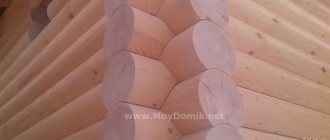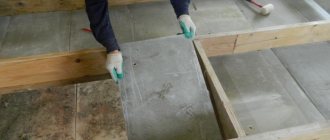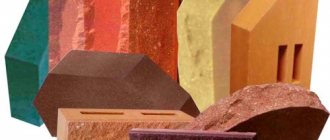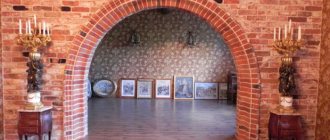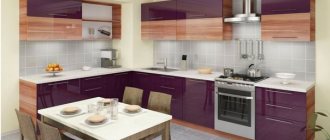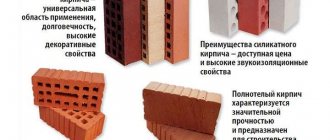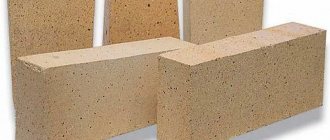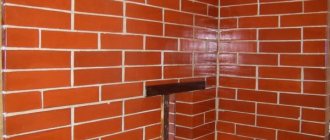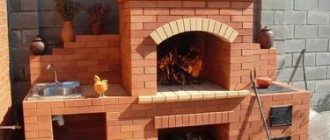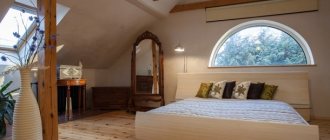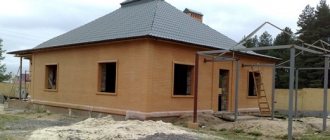When constructing objects from slotted building bricks, the cost of construction is much lower than usual, because when compared, for example, with a solid block, it costs much less.
Nowadays, high demands are placed on modern building materials.
Modern building material must have good thermal insulation and be strong enough. It is also very important that the building material is light in weight. Recently, slotted brick has undergone important changes; cracks have been introduced into its structure, the role of which is to reduce thermal conductivity.
Slotted bricks usually have standard dimensions, similar to building blocks.
There are three types of slotted building bricks:
single 250×120×65 mm;
one-and-a-half 250×120×88 mm;
double 250×120×138 mm;
The voids in the body of the brick also vary in shape and number of voids. According to their configuration, voids are divided into four types:
round;
oval;
rectangular;
square;
The number of voids can be different, their number varies from a few pieces to several dozen. Their minimum total volume can be 13%, and the maximum – 55%.
Advantages of slotted bricks
Today, slotted brick is used as a primary building material and is one of the leaders in sales, due to its significant advantages:
The structure of slotted bricks.
The most important role of slotted bricks is low thermal conductivity, because...
the comfort of the building and the costs of subsequent heating of the building depend on it. Also, during construction, the building does not require additional insulation of the walls. Durability. Due to its performance, slotted brick is one of the most durable.
The service life of a building built from slotted bricks is up to 50 years. Sound insulation. Having voids in its structure, slotted brick has excellent sound insulation. The air in the voids not only retains the heat of the building, but also serves to absorb extraneous sounds, thereby providing soundproofing.
Dimensions of double slot bricks
The size of the slotted brick complies with GOST 530-95 and GOST 7484-78 standards, which differ from the standard sizes of foreign-made material. If we compare the dimensions of a double stone with the dimensions of other products, we can reveal the following: Double slotted ceramic brick, designated 2.1 NF, has a size of 250x120x140 mm. Single slotted ceramic, designated 1 NF, has a size of 250x120x65 mm. One-and-a-half slotted ceramic, designated 1 ,4 NF, has a size of 250x120x88 mm.
In the first case, the weight of a hollow product will be 5 kg, and a solid one – 7.2 kg. In the second, the weight is 2.5 kg, and in the third, the product will weigh 3.3 kg.
Few would argue that brick has been one of the most popular building materials for a very long time. One of its forms, the so-called slotted brick, is the most common in many construction areas.
Such a product can be single or one-and-a-half in height, and its main distinguishing feature is through rectangular or round holes. It is they who make walls built from slotted brick incredibly warm by reducing the thermal conductivity coefficient. At the same time, the wall turns out to be thinner than when using solid brick. What’s especially nice is that this building material is made exclusively from safe natural materials – red clay and water.
Sometimes a natural dye is added to them, and then the brick becomes a facing brick. Ordinary brick is suitable for the construction of both internal and external walls of a building. Due to its low aesthetics and rough side surfaces, the final finishing of the wall requires the use of plasters, putties and paints to give it a finished look. Facing brick, as a type of slotted brick, has all the same performance characteristics. However, unlike standard ordinary brick, it has a plausible smooth surface, which allows it to be used when finishing an external wall. Produced according to GOST, it must still meet higher requirements than ordinary building bricks.
This is primarily explained by the need to withstand more severe climatic conditions of the external environment and a high probability of mechanical damage. Due to its properties, the double slotted building block occupies a niche between solid and porous bricks. For example, it has much better insulation than solid brick, but at the same time greater strength than porous brick. Domestic and foreign factories produce double slotted bricks of various shapes and sizes, including single, one-and-a-half and double. Moreover, in comparison with its solid counterpart, double slotted brick has two layers - outer and inner. The cavity formed between them is precisely the key to its heat-insulating and moisture-proof qualities. That is why this particular variety is most often used for the construction of walls and partitions that require increased thermal insulation.
In this sense, a building made of double slotted bricks and decorated with special facing bricks can be considered the highest quality. For the construction of walls and partitions, it is more reasonable to use double slotted bricks of grade 150. It is also used in the laying of load-bearing walls due to its special frost resistance and strength. It is not recommended to use blocks of a grade below 120-150 kg/cm2 in the construction of buildings due to the great danger of fighting of the slotted varieties.
How and from what are efficiency factors made?
The raw material for this brick - diatomite - is mined in Russia, in the large Inzenskoe deposit. It is there that it has the least amount of impurities, which allows it to be used without preliminary purification (enrichment). Diatomite contains oxides:
- 85% silicon;
- 6% aluminum;
- 3% iron;
- 6% calcium, titanium, sodium, magnesium and potassium.
The block is produced by mixing with clay and firing the foam mixture in molding ovens. Clay is added to give strength during baking, increase fire-resistant properties and adjust volumetric weight. In general, the process resembles the production of foam concrete, but with the participation of firing in a press oven.
For the production of this building material, the standards TU 5764–001–87745488–2010 and TU 5764–002–25310144–99 apply.
Types of bricks
Today's development of production technologies makes it possible to produce a huge variety of brick products, differing, in particular, in the shapes and sizes of internal cavities. The compositional characteristics and external textures of the blocks also differ, which each manufacturer can develop at its own discretion, observing accepted quality standards.
Double brick or, as it is also called, ceramic stone, is a product of “effective ceramics”. It has a corrugated surface, dimensions 250x120x138 mm and, due to its double structure, significantly speeds up the laying process.
The density of the brick is indicated by a digital coefficient (M 100, M 150), growing as it increases. Double slotted brick is distinguished by special voids that increase its heat and sound insulation.
Thanks to these qualities, walls made from such blocks will be much thinner and lighter without loss of performance characteristics. Particularly popular is brick grade M 150, used primarily for low-rise buildings. In addition, the pleasant color and smooth surfaces of this material make it possible not to use additional finishing after its application.
Milk brick can be not only slotted, but also solid.
Until recently, it was used in construction, which resulted in an increased load on the foundation. In addition, sound and heat insulation in such buildings left much to be desired. Therefore, today solid brick is gradually being replaced from the construction market by more modern analogues.
Many people confuse double slotted brick with its porous counterpart.
They, of course, have common features, but the process of their production and, as a consequence, operational characteristics are radically different: - slotted brick has volumetric holes of various shapes in its cavity, reducing its weight; - the difference in the production process of porous blocks is that that at the stage of mixing clay, raw sawdust is added to the mass. When bricks are baked, they burn out, leaving many small voids called pores. By reducing the thermal conductivity of the product, they thereby transfer it to the category of “warm ceramics”.
Also, modern brick is distinguished by a corrugated surface of the side edges, which makes the masonry more dense, economical and airtight.
It is also worth mentioning hyperpressed brick, which is a new generation product. Pressed under high pressure, it has an extreme degree of density and strength, guaranteeing it increased wear resistance and more than 100 guaranteed freeze-thaw cycles (that is, years of operation). Externally, such a product resembles natural stone and is produced in a wide range of colors and many textures, so its use is an interesting decorative solution in itself.
Slotted brick is used in the construction of load-bearing structures and partitions.
The material differs from solid stone in its low thermal conductivity and low weight. Slotted building bricks, being highly resistant to changes in temperature and humidity, can be used in various conditions for the construction of walls that can withstand minimal pressure. Hollow brick is not recommended for use in the construction of foundations, basements and basement floors.
Dimensions of ceramic blocks
Ceramic blocks are also used as insulation (their strength grade is M30-M50), and for the construction of load-bearing walls, blocks with a strength of M100 or higher are needed. They are made by adding special mineral additives to the clay.
Alexey Ektb FORUMHOUSE Member
If the blocks are standard, and not some test or discounted ones, then their safety margin is enough to allow you to lay floor slabs without any armored belt.
But such durable blocks have higher thermal conductivity, so walls made from them are lined with material with good heat-insulating properties.
UrailFORUMHOUSE Member
Any porous ceramic requires an external lining to protect the masonry from adverse weather conditions.
Very often, houses made of warm ceramics are built according to a combined scheme:
- the inner layer is made of durable ceramic blocks (this is about 60-70% of the wall thickness). Such blocks are selected based on the standard thickness of the supporting layer: 25, 38, 44 or 51 cm.
- The next layer is a layer of thermal insulation (20-30%),
- Then comes the outer cladding of half a brick made of low porosity brick (porosity is no more than 30%). The thickness of the cladding layer can be 8, 12 and 20 cm.
The strength of such a classic three-layer wall is equal to the strength of a pillar of 2.5 bricks of grade 100. And its thermal conductivity corresponds to the thermal conductivity of a 60-80 centimeter wall made of hollow brick.
Both masonry and facing blocks are laid only in a certain direction, connecting them with tongue and groove sides.
In practice, in Moscow and other cities and regions with a temperate climate, walls made of ceramic blocks 40 cm thick or more are not additionally insulated; only cladding and a plaster facade are used.
And this, judging by the reviews, is one of the main reasons for their popularity.
RomanF67FORUMHOUSE Member
I was building a house for a large family, three floors plus a garage complex. The house according to the project is large, has an impressive budget, and we spent a long time choosing materials with the customer. Ceramics are quite expensive, but we figured that if we spend more on materials now, we’ll definitely save on construction: ceramics don’t require so much mortar, and there’s no need for additional insulation with mineral wool. The cost of the house was within budget.
In Siberia, houses made of warm ceramics without insulation are built from blocks with a thickness of 51 cm. In the South, the best choice would be a 38th ceramic block.
Description of slotted brick
The main advantages of slotted bricks lie in its grade, which characterizes the material’s strength in bending and compression, frost resistance, durability and the ability to prevent heat loss. One-and-a-half slotted brick is considered a fairly economical building stone, allowing to reduce the consumption of mortar and the time spent on constructing the structure.
When deciding which slotted brick to buy, you should take into account that the larger the size of the stone, the less it is used per 1 m2. For example, a double face stone is twice the size of a single stone, but the difference in price is only 50%.
Ceramic slotted bricks are distinguished by strength indicators: from M 100 to M 200, where the number after the letter “M” indicates the compressive and bending strength of the stone.
The frost resistance of the material varies from F-15 to F-50 (that is, the stone can withstand 50 thawing cycles), and moisture absorption - from 8% to 20%. The choice of product depends on the requirements of the project and the feasibility of use. To make the right decision, you should study in more detail the properties and characteristics of building slatted stone.
Porous brick manufacturing technology
According to the technology, in addition to clay, sawdust, straw or peat are added to the raw materials, that is, only organic filler is used. The percentage of filler is within 30% of the total volume. As a result of firing, the filler burns out, resulting in a ceramic block with small pores.
Initially, the clay is freed from unnecessary impurities (stones), then it is crushed and moistened. Additives are added to the finished mixture. The resulting mixture is processed on a clay grinding device. In the mechanism, the mixture is rubbed until a homogeneous mass is obtained. This whole process is necessary to ensure that the product has a porous and durable structure.
Mass production of porous bricks using robots.
The crushed and mixed composition of the mixture is then formed in a vacuum press, which squeezes out the air from the composition. The formed clay is pushed out by a special molding auger, which makes holes in the brick. Next, using a steel string, the clay block is cut according to the required dimensions. Only cut bricks are sent to dry. Drying time can last from 40 to 70 hours, depending on the size of the products.
After drying, firing begins. Firing time 40 – 50 hours. Under the influence of temperatures up to 10,000 C0, the additives completely burn out, and the clay turns into a solid state, that is, it becomes ceramics. The product obtained by semi-dry pressing differs from ordinary brick in increased strength, high moisture resistance, but is lighter in weight.
The industry produces porous bricks with the following parameters:
- Single – 250x120x65;
- One and a half – 250x120x88;
- Double – 250x120x138.
Porous products are manufactured in the following formats: 2.1 NF; 10.7 NF No. 1; 10.7 NF No. 2; 14.3 NF.
Varieties of porous bricks.
The most popular blocks are the following sizes:
- construction porous, marked: 4.5-NF, dimensions: 250x250x138;
- large formats, super porous: 10.8-NF, 380x253x219;
- large formats, porous: 11.3-NF, 398x253x219.
Porous stones are distinguished by grade, which is determined by the value of the reliability limits during compression from M-75 to M-200.
Double slotted brick
Hollow bricks vary in size and are:
- single; one and a half (thickened); double.
The dimensions of double slotted brick, which is the most popular masonry stone in modern construction, can significantly save time spent on the construction of the facility and the amount of mortar (about 40%). The height of the stone is equal to the height of two standard bricks, taking into account the mortar between them: 250 x 120 x 140 mm.
The strength indicator of a double slotted product is the same as that of an ordinary and one-and-a-half slotted product and has a standard value: from M150 to M200. The optimal purchasing solution is a double slotted brick M 150, which retains all the characteristics inherent in this type of material, but has a lower cost.
Material consumption for laying:
- in half a brick (per 1 m2) - 25.7 pieces; per 1 m3 - 197.3 pieces; mortar per 1 m3 - 0.16 m3.
The calculation is correct for a layer of mortar 10 mm thick.
Execution of channels and niches
Channels and niches should not reduce the stability of the wall and should not run over lintels or other structural parts built into the wall. The dimensions of vertical grooves and niches in the masonry, permissible without additional assessment by static calculation, are given in table. 5.
| Dimensions of horizontal channels and niches in masonry, permissible without calculations |
Horizontal and oblique canals are undesirable. If they cannot be avoided, then they must be located at a distance of at least 1/8 of the height of the room from the lower or upper surface of the ceiling. Their depth, permissible without additional assessment by static calculations, is indicated in table. 6. If one of the indicators exceeds the values indicated in the tables, then the wall’s compressive strength, bending strength and shear resistance must be checked by calculation.
| Dimensions of horizontal and diagonal channels in masonry, permissible without calculations |
The maximum depth of a channel or niche includes the depth of any opening made in constructing the channel or niche. As for additionally punched vertical channels that rise above the floor level by no more than 1/3 of the height of the room, a depth of up to 80 mm and a width of up to 120 mm are permissible if the wall thickness is greater than or equal to 225 mm. The horizontal distance between adjacent channels or a channel and a niche or opening must be at least 225 mm. The horizontal distance between two adjacent niches located on one or both sides of the wall should be twice the width of the larger niche. The total width of channels and niches should not exceed the length of the wall multiplied by 0.13. The maximum depth of a channel or niche includes the depth of any opening made in constructing the channel or niche. The horizontal distance between the end of the channel and the hole must be no less than 500 mm. The horizontal distance between adjacent channels of limited length, laid on one or both sides of the wall, must exceed twice the length of the channel. For walls more than 115 mm thick, a channel 10 mm thicker than usual is allowed if it is cut to the required depth using special equipment. If the channels are cut out using special equipment, then the channels on both sides of the wall can be deepened by 10 mm only if the wall thickness is at least 225 mm. The width of the channels should not be more than 1/2 the thickness of the remaining wall. Manually gouging out channels in masonry using a hammer and chisel is slow and labor-intensive. To reduce labor intensity and speed up work, we recommend using special electrical equipment for channel cutting, which can be purchased at specialized power tool stores.
Read the continuation in the article - Construction of a house from ceramic porous bricks (blocks), part 2
One and a half hollow brick
One-and-a-half slotted ceramic bricks are marked M-150, F-50, and are used in the construction of internal partitions and filling openings. The height of the material is 1.35 of the height of a single product.
The hollowness of the material is 35%, and its size is 250x120x88 mm. The strength of the stone varies from M150 to M200. Laying one-and-a-half slotted bricks allows you to save time spent on construction of structures and the amount of mortar.
Material consumption:
- half a brick (per 1 m2) - 39.2 pieces; per 1 m3 - 301.9 pieces; mortar per 1 m3 - 0.19 m3.
The calculation is based on the thickness of the solution layer equal to 10 mm.
This is interesting: How to cut bricks for masonry? Choosing a manual press for brick production.
Single slotted brick
Single slotted brick is used for the construction of external and internal walls for finishing with facing material or plaster. During laying, voids are not completely filled with mortar, which virtually eliminates the appearance of “cold bridges” and increases the thermal insulation performance of structures.
The material is marked M100 - M200, where the number is an indicator of compressive and bending strength. Brick has a standard set of properties inherent in slotted building materials: low thermal conductivity (0.36-0.46 W/m °C), high frost resistance and moisture resistance. The dimensions of the single slot brick are 250x120x65 mm.
Material consumption for laying:
- half a brick (per 1 m2) - 51.3 pieces; per 1 m3 of masonry - 394.5 pieces; mortar per 1 m3 - 0.2 m3.
The calculation was performed for a layer of mortar 10 mm thick.
Disadvantages of houses made of ceramic blocks
The main disadvantage of ceramic blocks is their fragility.
- The outer walls of the blocks are thin, and the walls that define the voids are super thin. This material requires careful handling; it cannot be transported, loaded and unloaded at random.
- And the fastening capacity of the blocks is also low. On our portal you can find stories about how all the wall-mounted kitchen cabinets in the house from this material became floor-mounted. It’s true that block walls do not hold standard dowels, but this problem is easily solved with chemical anchors and fasteners for cellular concrete (which are more expensive than standard dowel fastenings). Although some of our users claim that if you drill blocks in a non-impact mode and with a Victory drill, avoiding excessive pressure, then any plastic dowels will hold on like a glove.
- Ideally, it is recommended to scrape walls for laying communications by hand, with a hammer and chisel. As a last resort, use wall cutters or angle grinders. The preforator in crushing mode can destroy blocks.
- Ceramic blocks absorb moisture perfectly, this must be taken into account. It is the high hygroscopicity that leads to cracks running through the blocks. Therefore: a mandatory layer of waterproofing between the foundation and the first row of masonry, protecting the wall from precipitation during construction and storing the material indoors.
- For a house made of ceramic blocks, the qualifications of the builders are very important. Not all masons know how to lay ceramic blocks; in some regions of our country it is impossible to find such specialists.
The installation technology is easy to break, and this leads to the formation of cold bridges and freezing of the walls. A house made of warm ceramics will be a damp and cold house. This is evidenced by reviews from people who have experience interacting with such builders.
GalenaForumHouse Member
Not all masons can lay large-format stones correctly. You need to use warm masonry mortar and carefully monitor how ceramic blocks are laid, especially in the corners of the house. Think in advance about how the stones will be cut so that you get even cuts and thus avoid cold bridges in the masonry.
Porizovka houses grow so quickly that builders sometimes do not meet the deadlines for the walls to gain the required strength and immediately install ceilings on them. Therefore, shrinkage of walls made of warm ceramics may also exceed permissible values.
Features of the use of the material
Slotted facing bricks are especially popular in regions where there are frequent temperature changes, and the most pressing problem is energy saving.
Builders, in order to provide residents with comfortable and warm housing, must build a wall whose density would help retain heat. The problem in this case is the large amount of bricks used to lay thick walls, which leads to an increase in the load exerted by the building on the foundation and the overall cost of construction work. As a result, this negatively affects the operational characteristics of the constructed facility and calls into question the economic feasibility of such construction.
Interesting articles: What is the weight of red solid brick 250x120x65? Technical characteristics of brick M 125.
An excellent solution is to use ordinary slotted bricks, which have the necessary lightness, low thermal conductivity and durability.
Porous building stone, used for the construction of walls and partitions, allows you to achieve the desired thermal insulation and sound insulation properties without unnecessary thickening of the walls. At the same time, the pores of bricks are different: open vertical and closed voids. The main advantages of the product are:
- light weight of slotted bricks, the indicator of which varies depending on the size of the material: from 2.3 kg to 4.7 kg; affordable price of slotted bricks, while the cost of a double product differs from the cost of a single one by only 50%.
The production of the material is based on low-melting clays. The hollowness index of the product reaches 35%, but it should be borne in mind that the higher it is, the higher the quality of the material.
Slotted brick is a modern building material that has high strength and good insulating properties.
Slit brick has high strength and low thermal conductivity.
This type of product got its name due to the presence of holes in the form of slots, thanks to which the weight of the erected structures became much less, but the performance qualities were preserved.
The use of slotted bricks allows you to reduce construction costs, because unlike solid blocks, it costs less.
Buy ceramic stone
Ceramic stone is a building material that is large in size and has internal voids - cracks.
It is the voids that distinguish warm ceramic stone from ordinary brick. Although recently double brick has also begun to be called ceramic stone. Double ceramic bricks are made from crushed clay, which is fired at high temperatures. In rare cases, other components of different nature are added to hollow ceramic stone. The internal voids of the ceramic stone are located in such a way that their combination increases the thermal insulation properties. A large-format ceramic block is a product that is made from fusible clay, chemical modifiers, and sawdust or husks. Thanks to the latter components, large-format ceramic blocks are also called large-format porous blocks. These components reduce the weight of the block and also increase the thermal insulation properties.
Both building materials are made from environmentally friendly materials that do not harm the environment. They are fired at almost the same temperatures.
View ceramic stone and large-format blocks in the product catalog
Advantages of slotted bricks
Today, hollow building material is a sales leader due to its advantages:
Installation of slotted bricks.
Low thermal conductivity.
This characteristic is one of the most important, since the comfort of the building and heating costs depend on it.
In addition, during construction there will be no need to additionally insulate the walls, which will reduce costs. Durability. Thanks to high strength indicators, not only the quality of erected structures improves, but also their service life increases. On average, a slotted double brick lasts 50 years. Sound insulation.
Hollow blocks protect rooms well from noise, since the free space in the material, filled with air, acts as a shield that prevents the spread of sounds. Saving.
During construction work, slotted bricks and cement mortar are consumed more economically than when using solid blocks. In addition, with the help of such material, the process of constructing structures moves much faster, especially if one-and-a-half or double products are used. Don’t forget about the price of bricks - it is much lower, which makes it possible to reduce the cost of construction.
How much brickwork does Penoplex replace?
For those who plan to order Penoplex, the ratio of thermal insulation material to brick plays an important role. We will tell you about the most popular thickness of thermal insulation boards and their correspondence to the thickness of the brickwork.
- Penoplex 20 mm replaces a brick wall with a thickness of 370 mm - this is almost 40 cm, that is, 20 times the thickness of the insulation itself. If you wanted to purchase reliable thermal insulation, but you were only stopped by ignorance of how much brick a 2 cm thickness of Penoplex replaces, today you learned an additional plus in the piggy bank of this material!
- How much does Penoplex 30 mm replace brickwork? Based on the data on the correspondence of 2 cm of insulation to a brick wall, it turns out that Penoplex 30 mm replaces as much as 555 mm of brickwork in terms of energy efficiency. Here is your answer to how many bricks 30 mm thick Penoplex replaces!
- What brick thickness does Penoplex 50 mm replace? A pleasant surprise awaits you! The technical characteristics of Penoplex 50 mm in comparison with brick will conquer not only the homeowner, but also the experienced developer. Brickwork 925 mm thick can be compared with 50 mm Penoplex - that’s how many bricks this insulation replaces!
Now that you have found out what wall thickness Penoplex replaces, there is no reason to put off the purchase of thermal insulation material - call us and order insulation at a favorable price today!
Types of bricks and their characteristics
Slotted bricks are available in a wide range, so you can easily purchase the most suitable material for the construction of a particular building. Products are classified according to a number of features:
- size; shape and number of slots; purpose; properties.
Shapes and number of slots/
Slotted products come in different sizes: single, one-and-a-half and double bricks are available on sale. For the construction of large objects, slotted double bricks are most often used, i.e.
because it significantly speeds up the work process and reduces the consumption of cement mortar. In addition, this material can be laid in 1 row, and at the same time the strength and thermal insulation characteristics of the structure will be quite high.
The number of cracks in a brick can vary between 15-55% of its total volume. It is important to consider that the more voids in the product, the lower its strength, but at the same time the thermal insulation qualities will be much better. The shapes of the holes are round, square, rectangular and oval.
As for the purpose, slotted bricks are divided into the following types:
Porous - intended for cladding work. This material is lightweight due to its porous structure, but at the same time is able to provide the building with good heat and sound insulation. Cement-sand brick is the cheapest brick, the characteristics of which are in no way inferior to other materials.
Cement, sand and synthetic additives are used to make it. Thermally efficient - a material with low thermal conductivity and low weight. It allows you to create lightweight structures with high performance. Thermally efficient single slotted brick, when laid in 1 row in the winter, will retain heat in the building, and in the summer will provide pleasant coolness. Foam diatomite - intended for the construction of objects that are exposed to high temperatures, such as blast furnaces or smelters.
Such products can withstand up to 900°C. In conventional construction, diatomite foam bricks are not used, which is explained by their high cost. Ceramic is a material with an aesthetic appearance and high thermal insulation properties. It is used for interior and exterior wall decoration.
Correct technique for laying walls
One of the supposed disadvantages of porous blocks is the partial elimination of porosity during the laying process due to cement mortar spilling into the cells. This phenomenon is eliminated by using a special mesh, which is placed in each row spacing and retains the binder. An ordinary fiberglass mesh can be used for facade plaster, but experts recommend using basalt mesh in order to increase the uniformity of the masonry mass.
Strictly speaking, cement mortar or sand concrete is not used in laying warm ceramics. They do not have a high enough resistance to heat transfer, so in technological construction liquid adhesive mixtures are used for polished blocks and lime mortar for unpolished ones. A dry block is dipped into a solution or adhesive mixture; the adhering layer is enough to reliably fasten the rows.
Cold bridges are not completely eliminated, but their number is reduced to a minimum. To completely eliminate thermal conductivity, it is customary to lay 30–50 mm of extruded polystyrene or cheaper PBS between the layers of masonry. At the same time, the vapor permeability of the wall is artificially limited by membranes of various types, and on the outside of the separator there remains a 30–50 mm gap for ventilation. If there is no insulation between the layers, when laying each row, roll out a 10 cm strip of polyethylene foam.
When bandaging elements of the same row, no binder is used. Technically, such a wall remains ventilated, which is why it is so important to have facade plastering with a thickness of 30 mm or more or facing it with traditional bricks and cement mortar. Sometimes this rule is deviated from in low-rise construction, and the outer layer of the wall made of insulating blocks is removed with finishing masonry. If there is no insulation between the layers of the wall, the gaps between the blocks are filled from the inside with polyurethane foam, the consumption of which is minimal due to the precise fit of the blocks.
